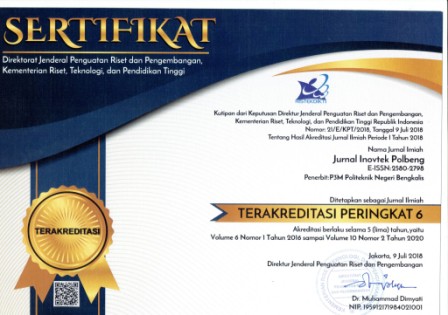Analisis Pengaruh Kesiapan Pemilik Kapal Dalam Pelaksanaan Retrofitting Sistem Ballast Kapal Tanker Menggunakan Pendekatan Dinamika Sistem
Abstract
IMO mewajibkan semua kapal existing yang beroperasi pada rute internasional untuk memasang Ballast Water Treatment System (BWTS). Pemasangan BWTS dilakukan dengan melakukan retrofitting kapal exiting yang dijadwalkan bersamaan dengan pembaruan survei International Oil Pollution Prevention (IOPP) dan paling lambat sebelum 8 September 2024. Retrofitting sistem Ballast Water Treatment System (BWTS) pada kapal existing. Retrofitting BWTS merupakan langkah yang memerlukan persiapan cermat oleh pemilik kapal, termasuk persiapan dokumen dan pelaksanaan survei atau 3D scaning. Hasil pengembangan model menggunakan pendekatan dinamika sistem menunjukkan bahwa ketidaktersediaan dokumen yang diperlukan dapat menyebabkan peningkatan biaya sebesar 1,7% dan penambahan durasi sebesar 1,4% dalam proses retrofitting kapal tanker. Hasil simulasi ini dapat digunakan sebagai dasar untuk merancang strategi mitigasi untuk menghindari kegagalan pemenuhan standar BWTS, mengurangi downtime, dan mengoptimalkan pengeluaran biaya.
Keywords
Full Text:
PDFReferences
Karahalios, Hristos, Z. L. Yang, and J. Wang, “A risk appraisal system regarding the implementation of maritime regulations by a ship operator,†Maritime Policy and Management, vol. 42, no. 4, pp. 389–413, 2015, doi: 10.1080/03088839.2013.873548.
L. T. P. Nghiem et al., “Economic and Environmental Impacts of Harmful Non-Indigenous Species in Southeast Asia,†PLoS ONE, vol. 8, no. 8, 2013, doi: 10.1371/journal.pone.0071255.
IMO, “Economic assesments for ballast water management: A guideline. GloBallast Monography Series No. 19,†no. 19, 2010.
J. A. Fernandes et al., “Costs and benefits to European shipping of ballast-water and hull-fouling treatment: Impacts of native and non-indigenous species,†Marine Policy, vol. 64, pp. 148–155, Feb. 2016, doi: 10.1016/j.marpol.2015.11.015.
Z. Wang, D. Nong, A. M. Countryman, J. J. Corbett, and T. Warziniack, “Potential impacts of ballast water regulations on international trade, shipping patterns, and the global economy: An integrated transportation and economic modeling assessment,†Journal of Environmental Management, vol. 275, p. 110892, 2020, doi: 10.1016/j.jenvman.2020.110892.
S. da S. Jorge and T. Satir, “Framework and implementation of a fuzzy logic filter—an optimization strategy for the BWMS based on stakeholders’ perspectives,†Environmental Science and Pollution Research, vol. 27, no. 30, pp. 37790–37801, Oct. 2020, doi: 10.1007/s11356-020-09807-9.
D. Å ateikiene, J. Januteniene, M. BogdeviÄius, and R. MickeviÄiene, “Analysis into the selection of a ballast water treatment system,†Transport, vol. 30, no. 2, pp. 145–151, 2015, doi: 10.3846/16484142.2015.1045025.
W. A. Gerhard, K. Lundgreen, G. Drillet, R. Baumler, H. Holbech, and C. K. Gunsch, “Installation and use of ballast water treatment systems – Implications for compliance and enforcement,†Ocean & Coastal Management, vol. 181, no. July, p. 104907, 2019, doi: 10.1016/j.ocecoaman.2019.104907.
Z. Wang, M. Saebi, J. J. Corbett, E. K. Grey, and S. R. Curasi, “Integrated Biological Risk and Cost Model Analysis Supports a Geopolitical Shift in Ballast Water Management,†Environ. Sci. Technol., vol. 55, no. 19, pp. 12791–12800, 2021, doi: 10.1021/acs.est.1c04009.
D. M. King and P. T. Hagan, “Economic and Logistical Feasibility of Port-Based Ballast Water Treatment: A Case Study at the Port of Baltimore (USA).†MERC Ballast Water Economics Discussion Paper No. 6, 2013.
L. ÄŒampara, M. SliÅ¡ković, and G. J. MrÄelić, “Key ballast water management regulations with a view on ballast water management systems type approval process,†Nase More, vol. 66, no. 2, pp. 78–86, 2019, doi: 10.17818/NM/2019/2.5.
Hardiyanto, T. Pitana, and D. W. Handani, “The Impact of Implementation New Regulation on Maritime Industry: A Review of Implementation BWTS,†in IOP Conference Series: Earth and Environmental Science, 2020, p. 10. doi: 10.1088/1755-1315/557/1/012058.
Hardiyanto, T. Pitana, and D. W. Handani, “Development Dynamic Compliance Cost Model For Implementation Of Ballast Water Management Convention: Shipowner Perspective,†JAES, pp. 1–14, 2023, doi: 10.5937/jaes0-42108.
Hardiyanto, T. Pitana, and D. W. Handani, “System Dynamics Model of Retrofitting Ship System to Comply with Ballast Water Convention,†IREA, vol. 11, no. 2, pp. 101–110, 2023, doi: https://doi.org/10.15866/irea.v11i2.22692.
D. M. King, M. Riggio, and P. T. Hagan, “Preliminary Cost Analysis of Ballast Water Treatment Systems.†MERC Ballast Water Economics Discussion Paper No. 1, 2009.
Hardiyanto, “Desain Model Compliance Cost Untuk Implementasi Konvensi Ballast Water Management (Bwm) Dengan Pendekatan Dinamika Sistem,†Dissertation, INSTITUT TEKNOLOGI SEPULUH NOPEMBER, Surabaya, 2023.
DOI: https://doi.org/10.35314/ip.v13i2.3658
Refbacks
- There are currently no refbacks.
Copyright (c) 2023 INOVTEK POLBENG
This Journal has been listed and indexed in :

inovtek polbeng by http://ejournal.polbeng.ac.id/index.php/IP is licensed under a Creative Commons Attribution-ShareAlike 4.0 International License









